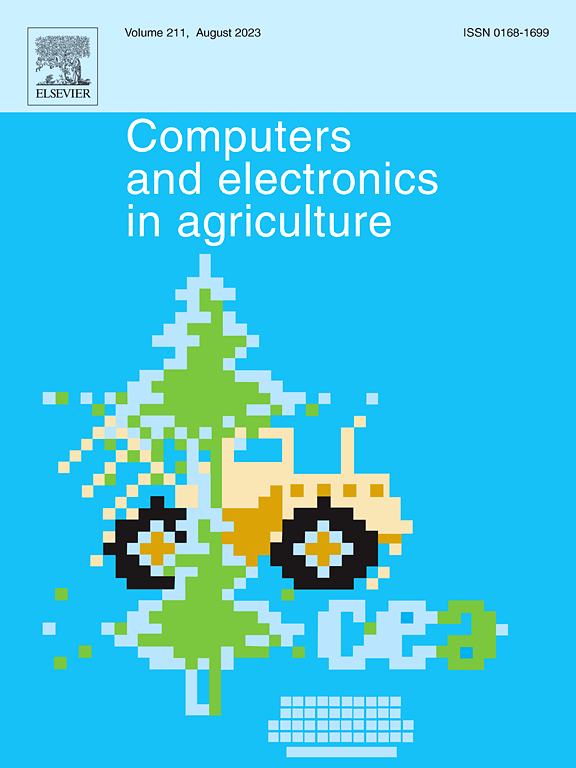Optimizing matrix barcode ground control points for automated location detection in UAS-based remote sensing
IF 8.9
1区 农林科学
Q1 AGRICULTURE, MULTIDISCIPLINARY
引用次数: 0
Abstract
High spatial accuracy is essential in unmanned aircraft system (UAS)-based remote sensing for applications in precision agriculture. Traditional ground control points (GCPs) improve the spatial accuracy of measurements derived from imagery but typically require manual tagging, a process that is both time-intensive and susceptible to errors. Matrix barcodes offer an opportunity to automate georeferencing in UAS-based remote sensing by addressing the bottlenecks associated with traditional GCPs in photogrammetry. This study aimed to refine the encoding process of matrix barcode GCPs, with objectives that included (1) evaluating the performance of several barcode types for use in GCP applications; and (2) assessing different compression methods for encoding geographic coordinates within the barcodes. Field tests showed that Aztec and Micro QR codes provided more reliable recovery at higher altitudes—up to 45 m above ground level compared to standard QR codes—attributed to their larger module sizes. Statistical analysis identified altitude and barcode type as significant factors impacting barcode recovery, with Aztec and Micro QR codes showing a 55–57 % higher recovery rate compared to standard QR codes for 1.07 x 1.07 m GCPs. While statistical analysis found no significant differences among encoding methods, field tests indicated that binary encoding had relatively improved performance, particularly when paired with Aztec codes. However, environmental data collection did not fully support one-to-one comparisons across different days; as such, the results should be interpreted within the specific conditions of this study rather than as definitive conclusions. Overall, these findings offer insights into the feasibility of using matrix barcodes as an automated alternative to traditional GCPs, potentially improving the efficiency of UAS-based remote sensing workflows by reducing the labor, time, and risk of user error associated with manual GCP processing.
优化矩阵条码地面控制点的自动定位检测基于无人机遥感
高空间精度是无人机遥感技术在精准农业应用中的关键。传统的地面控制点(gcp)提高了来自图像的测量的空间精度,但通常需要人工标记,这一过程既耗时又容易出错。通过解决摄影测量中与传统gcp相关的瓶颈,矩阵条形码为基于无人机的遥感中的自动地理参考提供了机会。本研究旨在改进矩阵条形码GCP的编码过程,其目标包括:(1)评估几种条形码类型在GCP应用中的性能;(2)对条形码中地理坐标编码的不同压缩方法进行了评估。现场测试表明,与标准QR码相比,Aztec和Micro QR码在高海拔(距离地面45米)提供了更可靠的恢复,这归功于它们更大的模块尺寸。统计分析发现海拔高度和条形码类型是影响条形码回收率的重要因素,在1.07 x 1.07 m gcp中,Aztec和Micro QR码的回收率比标准QR码高55 - 57%。虽然统计分析发现编码方法之间没有显着差异,但现场测试表明,二进制编码的性能相对提高,特别是与阿兹特克代码配对时。然而,环境数据收集并不能完全支持不同日子间的一对一比较;因此,结果应在本研究的特定条件下解释,而不是作为确定的结论。总的来说,这些发现为使用矩阵条形码作为传统GCP的自动化替代方案的可行性提供了见解,通过减少人工、时间和与手动GCP处理相关的用户错误风险,有可能提高基于无人机的遥感工作流程的效率。
本文章由计算机程序翻译,如有差异,请以英文原文为准。
求助全文
约1分钟内获得全文
求助全文
来源期刊

Computers and Electronics in Agriculture
工程技术-计算机:跨学科应用
CiteScore
15.30
自引率
14.50%
发文量
800
审稿时长
62 days
期刊介绍:
Computers and Electronics in Agriculture provides international coverage of advancements in computer hardware, software, electronic instrumentation, and control systems applied to agricultural challenges. Encompassing agronomy, horticulture, forestry, aquaculture, and animal farming, the journal publishes original papers, reviews, and applications notes. It explores the use of computers and electronics in plant or animal agricultural production, covering topics like agricultural soils, water, pests, controlled environments, and waste. The scope extends to on-farm post-harvest operations and relevant technologies, including artificial intelligence, sensors, machine vision, robotics, networking, and simulation modeling. Its companion journal, Smart Agricultural Technology, continues the focus on smart applications in production agriculture.
 求助内容:
求助内容: 应助结果提醒方式:
应助结果提醒方式:


